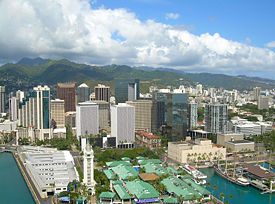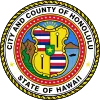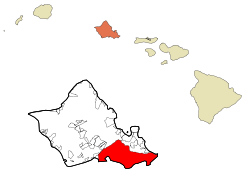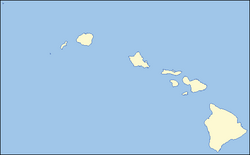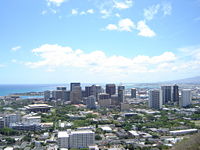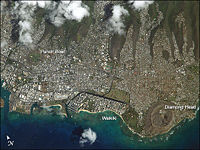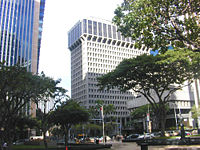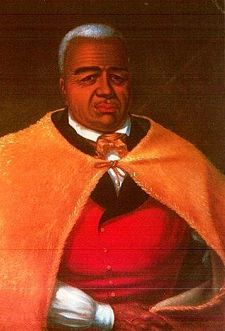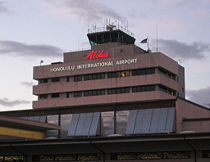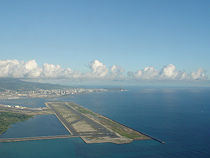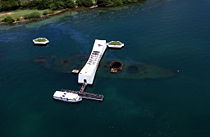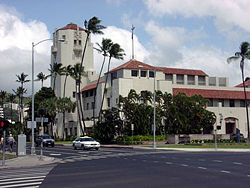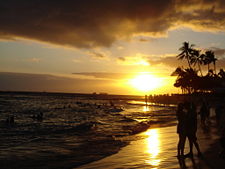| Honolulu, Hawaii | |||
| â  State capital city  â | |||
| Aerial view of downtown from Honolulu Harbor | |||
|
|||
| Nickname: Crossroads of the Pacific, Sheltered Bay, The Big Pineapple, Paradise | |||
| Location in Honolulu County and the state of Hawaii | |||
| Location in Honolulu County and the state of Hawaii | |||
| Coordinates: 21°19â²N 157°50â²W | |||
|---|---|---|---|
| Country | United States | ||
| State | Hawaii | ||
| County | Honolulu | ||
| Area | |||
|  - State capital city | 1,177.8 sq mi (3,050.5 km²) | ||
|  - Land | 88.9 sq mi (230.2 km²) | ||
|  - Water | 1,088.9 sq mi (2,820.2 km²) | ||
| Elevation | 0Â ft (Sea Level 0Â m) | ||
| Population (2010) | |||
| Â -Â State capital city | 390,738 (47th) | ||
|  - Density | 4,393.2/sq mi (1,696.2/km²) | ||
| Â - Metro | 953,207 | ||
| Time zone | HAST (UTCâ10) | ||
| Zip Code | 96801-96850 | ||
| Area code(s) | 808 | ||
| FIPS code | 15-17000 | ||
| GNIS feature ID | 0366212 | ||
Honolulu is the capital and most populous city area in the United States state of Hawaii. Although Honolulu refers to the urban area on the southeastern shore of the island, the city and the county are consolidated, known as the City and County of Honolulu. The city and county is designated as the entire island of Oahu. It is administered as a single entity and is home to approximately 80 percent of the stateâs population. The City and County of Honolulu is the only incorporated city in Hawaii, as all other local government entities are administered at the county level.
Honolulu's history includes habitation beginning in the twelfth century C.E., annexation as a protectorate of the United States in 1900, and attack on Pearl Harbor by Imperial Japanese forces in 1941. The result of the attack led to America's entry into the World War II and the defeat of both Nazi Germany and Imperial Japan.
Honolulu is at the crossroads of trans-Pacific Ocean shipping and air routes and the focal point of inter-island services. It is the commercial and industrial center of the Hawaiian Islands. Waikīkī Beach adjacent to Honolulu attracts millions of tourist visitors annually. Aloha Stadium, Pearl Harbor and the USS Arizona Memorial, and Hickam Air Force Base are nearby. In the Hawaiian language, Honolulu means "sheltered bay" or "place of shelter."
Geography
In the Hawaiian language,Honolulu means "sheltered bay" or "place of shelter."
Honolulu extends about 10 miles (16km) along the southeast coast of the island of Oahu, and goes four miles (six kilometers) inland across a plain into the foothills of the Koolau Range. The closest location on the mainland of the United States to Honolulu is the Point Arena, California Lighthouse, at a distance of 2,353 miles or (3,787 kilometers).
Within Honolulu proper can be found several volcanic cones: Punchbowl, Diamond Head, Koko Head (includes Hanauma Bay), Koko Crater, Salt Lake, and Aliamanu being the most conspicuous.
While the city is clearly in the tropics, the climate is moderated by its mid-ocean location, and has a warm semi-arid climate. The average maximum daytime temperature in January is 80°F (27°C), rising to an average maximum of around 88°F (31°C) in July. Temperatures exceed 90°F (32°C) only rarely, with lows in the 50s°F (15°C) occurring perhaps once or twice in a year. Mean annual precipitation is 22 inches (558 mm).
The city-county covers an area of 597 square miles (1,545 square kilometers) and comprises all of Oahu and some outlying islets.
Most of the city's commercial and industrial developments are located on a narrow but relatively flat coastal plain, while numerous ridges and valleys located inland of the coastal plain divide Honolulu's residential areas into distinct neighborhoods: some spread along valley floors (like Manoa in Manoa Valley) and others climb the interfluvial ridges.
Downtown Honolulu is the financial, commercial, and governmental center of Hawaii. On the waterfront is Aloha Tower, which for many years was the tallest building in Hawaii. The tallest building in 2008 was the 438-foot (134Â m)-tall First Hawaiian Center, located at King and Bishop Streets.
Kakaako is a light-industrial district between Downtown and WaikÄ«kÄ« that has seen large-scale redevelopment in the past decade, and has two major shopping areasâWard Warehouse and Ward Centre.
Waikiki is the world famous tourist district of Honolulu, located between the Ala Wai Canal and the Pacific Ocean next to Diamond Head. Numerous hotels, shops, and nightlife opportunities are located along Kalakaua and Kuhio Avenues. Waikīkī Beach attracts millions of visitors a year. Just west of Waikīkī is Ala Moana Center, the world's largest open-air shopping center.
Aloha Stadium, Pearl Harbor (with the USS Arizona Memorial), and Hickam Air Force Base are located in the island's Ewa District.
History
The islands were first settled by Polynesians, either during the second half of the first millennium C.E. or by voyagers from the Marquesas sometime before 500 C.E., and then by immigrants from Tahiti around 1300 C.E.
Oral histories and artifacts indicate that there was a settlement where Honolulu now stands in the twelfth century.
Juan Gaetano, a Spanish navigator, may have visited in 1555. On January 18, 1778, Captain James Cook arrived and was surprised to find high islands so far north. He named them the "Sandwich Islands," after the First Lord of the Admiralty, the Fourth Earl of Sandwich, John Montagu.
After Kamehameha I (c. 1737-1819) conquered Oʻahu in the Battle of Nuʻuanu at Nuʻuanu Pali, he moved his royal court from the Island of Hawaiʻi to Waikīkī in 1804. His court later relocated, in 1809, to what is now downtown Honolulu.
Captain William Brown of England was the first foreigner to sail, in 1794, into what is now Honolulu Harbor. More foreign ships would follow, making the port of Honolulu a focal point for merchant ships traveling between North America and Asia.
In 1845, Kamehameha III moved the permanent capital of the Hawaiian Kingdom from Lahaina on Maui to Honolulu. He and the kings who followed him transformed Honolulu into a modern capital, erecting buildings such as St. Andrew's Cathedral, Ê»Iolani Palace, and AliÊ»iÅlani Hale. At the same time, Honolulu became the center of commerce in the Islands, with descendants of American missionaries establishing businesses in downtown Honolulu.
Despite the turbulent history of the late nineteenth century and early twentieth century, which saw the overthrow of the Hawaiian monarchy, Hawaiʻi's subsequent annexation by the United States on February 22, 1900, and the Japanese attack on Pearl Harbor December 7, 1941, Honolulu would remain the capital, largest city, and main airport and seaport of the Hawaiian Islands.
An economic and tourism boom following statehood brought rapid economic growth to Honolulu and Hawaiʻi. Modern air travel would bring thousands, eventually millions, of visitors per year to the Islands.
Honolulu is a modern city with numerous high-rise buildings, and Waikīkī is the center of the tourism industry in Hawaiʻi, with thousands of hotel rooms.
Government
The state government of Hawaii is modeled after the U.S. federal government with adaptations originating from the kingdom era of Hawaiian history. The Governor of Hawaii is assisted by the lieutenant governor, both elected. The Hawaii State Senate comprises 25 members, and the Hawaii State House of Representatives comprises 51 members.
Honolulu is administered under a consolidated city-county form of government employing a strong mayor-council system. The Mayor of Honolulu holds executive privilegesâas opposed to mayors with only ceremonial powersâand the Honolulu City Council serves as the legislature. The mayor and city council administer the Honolulu Fire Department and Honolulu Police Department through appointed officials.
The city and county of Honolulu is divided into nine administrative districts, each of which elects a member of the city council. The boundaries of each district are revised every 10 years in conjunction with the U.S. Census. Each district is composed of unincorporated subdivisions unofficially called towns and cities.
The official seat of governance for the city and county is located within the district at Honolulu Hale, established in the 1920s as a city hall structure and houses the chambers of the Mayor of Honolulu and the Honolulu City Council.
Economy
Honolulu is the crossroads of trans-Pacific shipping and air routes, and is the focus of inter-island services. Since statehood was achieved in 1959, tourism has been the largest industry, contributing 24.3 percent of the gross state product in 1997. New efforts were underway to diversify the economy. The per capita income for the census designated place was $24,191.
Numerous manufacturing plants in Honolulu include pineapple canneries, sugar refineries, clothing factories, and steel, aluminum, oil, cement, and dairy enterprises.
Several freeways and highways link Honolulu proper with other parts of the Island of Oahu. The Honolulu metropolitan area has heavy traffic congestion during rush hours.
Located on the western end of Honolulu proper, Honolulu International Airport is the principal aviation gateway to the state of Hawaii, and is one of the busiest in the United States. Honolulu Harbor, with extensive docks, warehouses, and storage sheds, is the principal port of Hawaii.
Dubbed "America's Best Transit System" for three years, Honolulu's The Bus system operates 107 routes serving Honolulu and outlying areas on Oahu with a fleet of 531 buses.
There is no urban rail transit system in Honolulu, although electric street railways were once used. After 20 years of political maneuvering, in 2008, the residents of Honolulu voted to continue developing a rail project for electric trains approximately 200 feet long, capable of carrying more than 300 passengers.
Demographics
The population of the census designated place that would cover Honolulu city was 371,657 at the 2000 census, while the combined population of the city and county was 909,863. The total population of Hawaii was 1,211,537 in 2000.
Census designated places are delineated to provide data for settled concentrations of population that are identifiable by name but are not legally incorporated under the laws of the state in which they are located.
The racial makeup was 19.67 percent White, 1.62 percent Black or African American, 0.19 percent Native American, 55.85 percent Asian, 6.85 percent Pacific Islander, 0.89 percent from other races; and 14.93 percent from two or more races. Hispanic or Latino of any race were 4.37 percent of the population.
Hawaiian and English are the two official languages. Hawaiian is required in official state business, while standard Hawaiian English, a subset of American English, is commonly used for other formal business. As of 2000, 73.4 percent of Hawaii residents aged five and older spoke only English at home and 7.9 percent spoke Pacific Island languages. Tagalog is the third most spoken language at 5.4 percent, followed by Japanese at 5 percent, and Chinese at 2.6 percent. Hawaiian Pidgin is an unofficial language.
Sixty-eight percent of Hawaiians identify themselves as Christianâ42 percent are Protestant, 24 percent Catholic, two percent Latter Day Saints, 18 percent agnostic/non-religious, nine percent Buddhist, and five percent listed themselves as either Shinto, Tao, or other.
Colleges and universities in the Honolulu community include University of Hawaii at Manoa, Chaminade University, and Hawaii Pacific University.
Society and culture
The Honolulu Academy of Arts is endowed with the largest collection of Asian and Western art in Hawaii. It also has the largest collection of Islamic art, housed at the Shangri La estate. The academy hosts a film and video program dedicated to arthouse and world cinema in the museum's Doris Duke Theatre, named for the academy's historic patroness Doris Duke (1912â1993).
Established in 1900, the Honolulu Symphony is the oldest U.S. symphony orchestra west of the Rocky Mountains. Other classical music ensembles include the Hawaii Opera Theatre. Honolulu is also a center for Hawaiian music. The main music venues include the Neal Blaisdell Center Concert Hall, the Waikiki Shell, and the Hawaii Theatre.
Honolulu has several venues for live theater, including the Diamond Head Theatre. Places of interest include:
- The USS Arizona Memorial, which is located at Pearl Harbor, marks the resting place of 1102 of the 1177 sailors killed on the USS Arizona during the Attack on Pearl Harbor on December 7, 1941, by Japanese imperial forces and commemorates the events of that day.
- Waikiki, which has a beach lined with luxury hotels, and has an aquarium (a working marine biology laboratory), a zoo, and the lively International Market Place for Pacific basin crafts, is the main destination for tourists.
- The Bishop Museum, the largest of Honolulu's museums, is endowed with the state's largest collection of natural history specimens and the world's largest collection of Hawaiiana and Pacific culture artifacts.
- The Contemporary Museum, which is the only contemporary art museum in Hawaii, has a main campus in Makiki and a multi-level gallery in downtown Honolulu at the First Hawaiian Center.
- The Hawaii State Art Museum is also located in downtown Honolulu and boasts a collection of art pieces created by local artists as well as traditional Hawaiian art. The museum is administered by the Hawaii State Foundation on Culture and the Arts.
- Honolulu is home to the Foster Botanical Garden, Liliuokalani Botanical Garden, Walker Estate, among others.
The Honolulu Marathon, held annually on the second Sunday in December, draws more than 20,000 participants each year, about half to two thirds of them from Japan. The Honolulu Triathlon is an Olympic distance triathlon event governed by USA Triathlon, and is held annually in May since 2004.
Honolulu hosts the NFL's annual Pro Bowl each February in addition to the football Hawaii Bowl. Honolulu also supports the Hawaii Winter League. Venues for spectator sports include: Les Murakami Stadium at UH-Manoa (baseball), Stan Sheriff Center at UH-Manoa (basketball and volleyball), and the Neal Blaisdell Center Arena (basketball).Aloha Stadium, a venue for American football and soccer, is located in nearby community of ʻAiea.
Looking to the future
Honolulu is the crossroads of trans-Pacific shipping and air routes, and is the focus of inter-island services. Tourism continues as the largest industry. Honolulu's greatest challenge seems to be agreeing on an urban light rail system, to help deal with traffic congestion. The city's legacy would be its repository of Hawaiiana and Pacific culture artifacts.
ReferencesISBN links support NWE through referral fees
- Artle, Roland. "Planning and growth-a simple model of an island economy: Honolulu, Hawaii." Regional Science Association. Papers and Proceedings, 1965. OCLC 81499666
- Gessler, Clifford. Tropic Landfall; the Port of Honolulu. Garden City, NY: Doubleday, Doran & Co., 1942. OCLC 349012
- Kali, Marilyn, and Benjamin R. Schlapak Honolulu International Airport: The First 80 Years, 1927-2007. Honolulu, HI: State of Hawaii, Department of Transportation, 2007. ISBN 978-0972954013.
- McClure, George Edward. A Study of the Structure of a Metropolitan Economy: Honolulu. 1965. OCLC 16344468
- Mohr, James C. Plague and Fire: Battling Black Death and the 1900 Burning of Honolulu's Chinatown. New York: Oxford University Press, 2005. ISBN 978-0195162318.
- Simpson, MacKinnon, and John Brizdle. Streetcar Days in Honolulu: Breezing Through Paradise. Honolulu, HI: JLB Press, 2000. ISBN 978-0970621382.
External links
All links retrieved July 19, 2024.
Credits
New World Encyclopedia writers and editors rewrote and completed the Wikipedia article in accordance with New World Encyclopedia standards. This article abides by terms of the Creative Commons CC-by-sa 3.0 License (CC-by-sa), which may be used and disseminated with proper attribution. Credit is due under the terms of this license that can reference both the New World Encyclopedia contributors and the selfless volunteer contributors of the Wikimedia Foundation. To cite this article click here for a list of acceptable citing formats.The history of earlier contributions by wikipedians is accessible to researchers here:
The history of this article since it was imported to New World Encyclopedia:
Note: Some restrictions may apply to use of individual images which are separately licensed.
